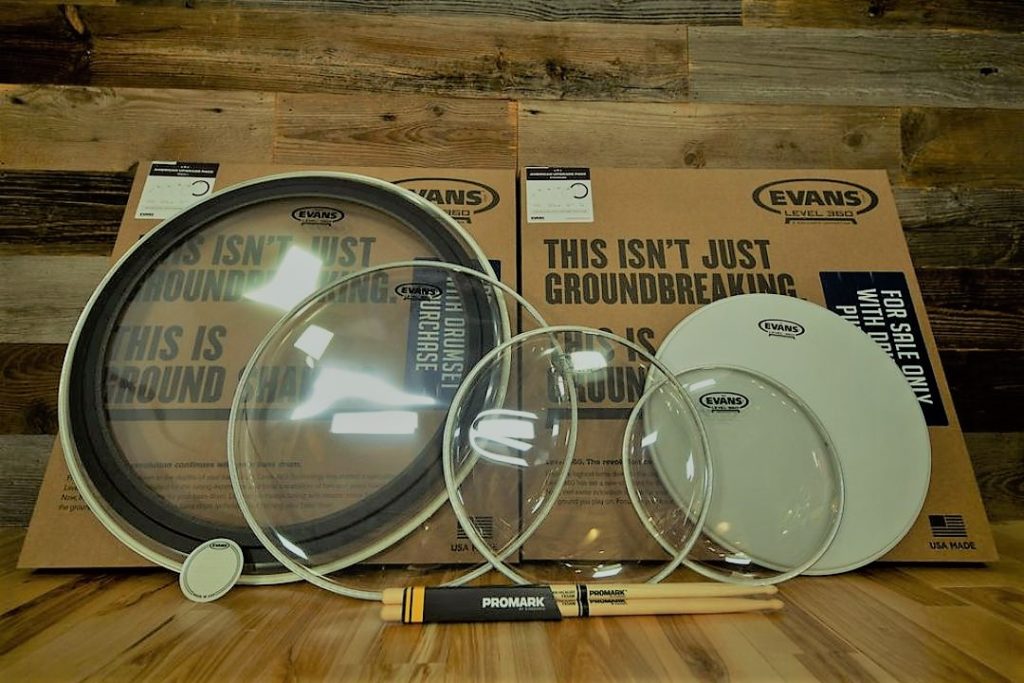Besides the wood your drum kit is made of, choosing the best drum heads for that particular kit has the biggest impact on your final sound.
That’s why the best short-term upgrade any drummer can make is to replace all of its drum heads as soon as possible.
Especially drummers that just bought a brand-new drum set. It doesn’t matter if it cost $300 or $3000, it always arrives with low-end drum heads with the drum company logo.
They are usually from a well-known drum head brand, like Remo. The difference is, instead of being Remo, made in the USA, they’re usually Remo, made in China (or something similar).
And trust me, made in China or USA, is completely different in terms of both build and sound quality. You won’t get the most out of your drums with Remo drum heads made in China.
Plus, a decent set of drum heads and the correct tuning can make any $300 drum set sound like a $3000 one.
Amazing, right? Time to replace them all! But wait, is there such thing as the best drum heads?
Actually… no! The best drum heads are the right drum heads for the sound you’re looking for, for your playing style, or the music genre you play the most.
It’s all subjective and what might be the best drum heads for me could be entirely different from the best drum heads for you.
Start by focusing on the sound you’re aiming for, and then decide which drum heads you should buy.
With that in mind, before deciding which drum heads fit your drum kit and your playing style perfectly, you need to understand what differentiates them.
Let’s start with:
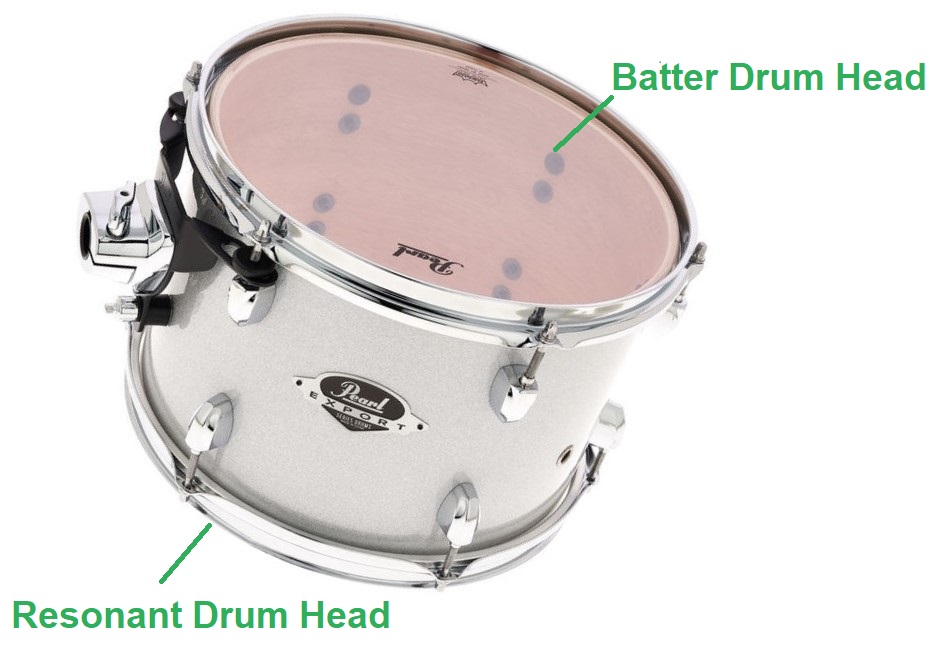 Batter vs Resonant heads:
Batter vs Resonant heads:
Batter Heads: also known as the top head, is the part of the drum that you hit while playing;
Resonant Heads: also known as the bottom head, or even reso drum head, is the part of the drum that resonates off the vibrations from the batter head. Some drums, especially vintage ones, don’t include resonant heads.
Nothing stops you from using batter heads as resonant heads, or vice versa. The first is quite common, and it works pretty well.
Single vs Double Ply:
Single Ply: the drum head is made out of one layer of plastic. They are usually the most basic and thinnest type of drum heads, with 10-mil Mylar being the most used thickness.
Single Ply drum heads allow for a higher pitch and brighter frequencies plus increased sustain and overtones. They are used the most in softer styles of music, like Jazz.
You can still use Single Ply drum heads as a metal drummer, but they are usually not as durable as Double Ply drum heads and that might not be ideal for a metalhead.
Being Single Ply provides more freedom when it comes to vibration, which makes them great resonant drum heads.
I currently use Evans G1 as my reso heads, even though they’re batter heads, and they work just fine. Remo Ambassador and Aquarian Studio X are other well-known Single Ply drum heads.
Note: A Mil means 1/1,000th of an inch, and not 1mm. In our example, 10-mil Mylar simply means 0.010” Mylar.
Double Ply: the drum head is made out of two layers of plastic; They are usually thicker than Single Ply drum heads, with most being made of two layers of 7-mil Mylar.
Unlike Single Ply drum heads, they mute high frequencies, emphasizing warmer mids and lows.
They also exhibit a shorter sustain, higher definition, and fewer overtones, not to mention, increased durability. That makes them great for heavier types of sounds and playing styles where durability and definition are important.
With that in mind, it’s pretty easy to conclude Double Ply drum heads don’t make great resonant heads. The two plies don’t vibrate as freely as a single ply, which is an important characteristic of a good resonant drum head.
Remo Emperor, Evans G2 (the ones I pair with the Evans G1 at the bottom), and Aquarian Performance II are good examples of Double Ply drum heads.
Confused? Here’s an ELI5:
Two plies, or two layers of plastic, vibrate against each other, which means they spend less time vibrating. In other words, they have a shorter sustain (time spent vibrating).
They are also thicker (usually 7+7 Mil vs 10 Mil on a single-ply), resulting in them vibrating at a lower frequency. That results in fewer overtones and a lower pitch than one-ply drum heads.
Clear vs Coated Heads
Clear Heads: they have more of everything. More attack (than coated heads), brighter sound, plus more sustain and overtones. They are also slightly louder, which makes them the perfect choice for situations where the drums need to stand out
Coated Heads: are the opposite of clear heads. They have a warmer sound, as the coating highlights lower pitch frequencies. The coating dampens the head which results in both less sustain and overtones. They are perfect for quieter situations like acoustic gigs, for example.
Most drummers go with clear heads for the toms and bass drum and coated heads for the snare drum. Some, like me, play with a full set of coated heads thanks to personal preference.
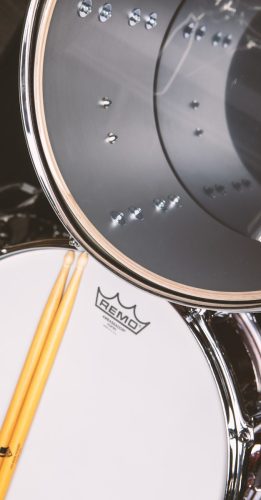
Dampened vs Undampened Heads
Dampened Heads: most drum heads manufacturers, like Remo, Evans, and Aquarian, sell drum heads with built-in dampening. That can be in the form of control dots, control rings, inlay rings, and felt strips (the less common option, only available for the bass drum). Dampened drum heads reduce overtones, making it easier to tune.
- Control Dots: give you shorter sustain but make the drum head considerably more durable. A good example of drum heads with control dots is the Remo Emperor X, Evans Power Center Dot, and Aquarian Power Dot.
- Control Rings: remove a little bit of sustain, overtones, and brightness. You can find control rings in Remo Pinstripe, Evans EMAD, and Aquarian Performance II.
- Inlay Rings: same as control rings, but in a different location. Good drum heads with inlay rings are Remo P4, Evans Genera, and Aquarian Focus X.
- Felt Strips: the rarest of the built-in dampening, it also reduces sustain, overtone and brightness. They are only available for bass drums and Remo Felt Tone and Aquarian Vintage Felt Strip are a few good examples.
Undampened Heads: drum heads that lack built-in dampening, which results in more sustain and overtones. If you favor versatility, undampened drum heads should be your go-to, since you can always add external dampening to control the sound, if necessary.
Some examples of undampened heads are the ones I use the most, Evans G1 and G2. Remo Ambassador and Emperor or Aquarian Hi-Frequency or Super II are also some of the most used undampened drum heads.
To sum it up, everything like the number of plies, the finish, and the dampening, or the lack of it, affects the sound of your drum set.
Your decision is always based on the sound you wish to achieve, what type of music do you plan to play, and what drum kit you own.
Thinner heads provide a brighter sound, are more responsive, and produce more sustain and overtones at the expense of durability.
Thicker, on the other hand, provides a warmer sound with less sustain and overtones. That ends up with increased durability at the expense of responsiveness.
Now that we know the anatomy of a drum head and the influence they have on the sound of our drum set, here’s a list of the best drum heads (for each drum and type of sound you’re looking for):
Best Snare Drum Heads
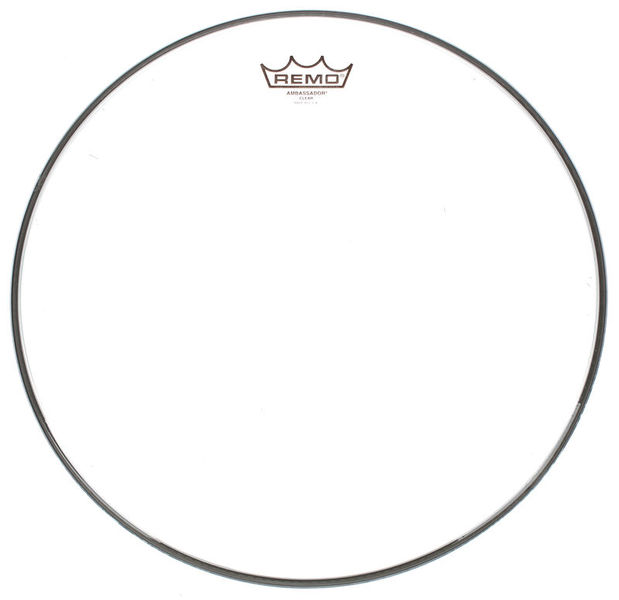 This is one of the classic single-ply drum heads and for a good reason. With three options available, Clear, Coated and X Coated, there’s a drum head for everyone.
This is one of the classic single-ply drum heads and for a good reason. With three options available, Clear, Coated and X Coated, there’s a drum head for everyone.
The Remo Ambassador Clear is a single ply, 10mil, drum head with an open, bright sound and good sustain.
It’s mostly used as a snare drum head, but it can also be used as a bass drum or a tom drum head since it’s available in sizes ranging from 6” to 40”.
The 10mil single-ply makes it a great option as tom and bass drum heads since it provides a lot of sustain and depth.
If you plan to use brushes, or favor a slightly warmer sound with less attack, pick the Remo Ambassador Coated instead.
The Ambassador X Coated is as responsive as the Ambassador Coated but adds more durability and a little bit of attack and warmer tones.
If you’re looking for versatility, stick with the Clear option, since you can add moongels or ring controls later to control or warmth the sound.
Thanks to the fact that all three options are single ply, durability isn’t their strong point. On that note, you should avoid them if that’s what you value the most.
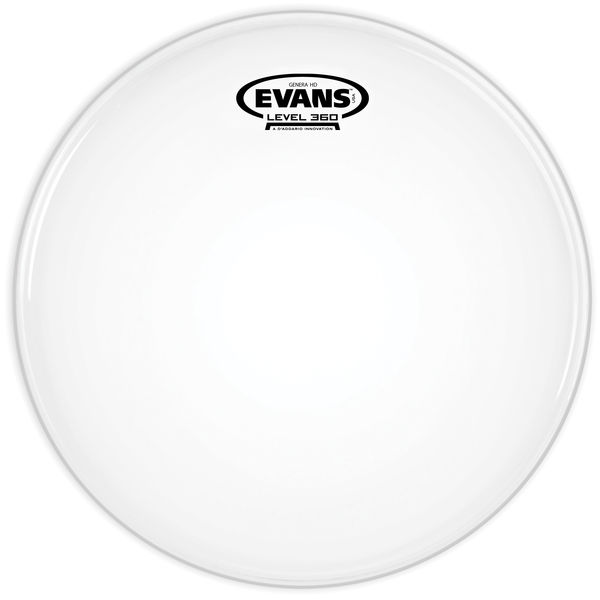 Unlike Remo Ambassador, Evans HD Coated is a 2-ply drum head, with a 5mil ply on top of a 7.5mil ply and a 2mil overtone control ring on the underside.
Unlike Remo Ambassador, Evans HD Coated is a 2-ply drum head, with a 5mil ply on top of a 7.5mil ply and a 2mil overtone control ring on the underside.
The control ring eliminates excessive overtones while keeping the sustain under control.
It’s a snare drum head with a very good attack, balanced sound, and is incredibly easy to tune, thanks to the coating and the control ring.
Being 2-ply makes it fairly durable, which is ideal for any heavy hitter, but keep in mind that it’s still thinner than most 2-ply drum heads that are usually something like 7+7mil.
Sadly, there’s no clear option, but thanks to being thinner than most 2-ply drum heads, this is a versatile drum head that suits most play styles.
If you’re looking for a similar sound, but want more control over the sustain and overtones, the Evans HD Dry Coated is a great option.
What differentiates the Dry version from the regular version is the precision-drilled dry vents around the perimeter of the head that aim to reduce even more overtones and sustain.
That additional features make the HD Dry Coated perfect for anyone that’s looking to stop the snare drum from ringing too much.
Evans builds HD Coated and HD Dry Coated for snare drums so they are only available in sizes ranging from 12” to 14”.
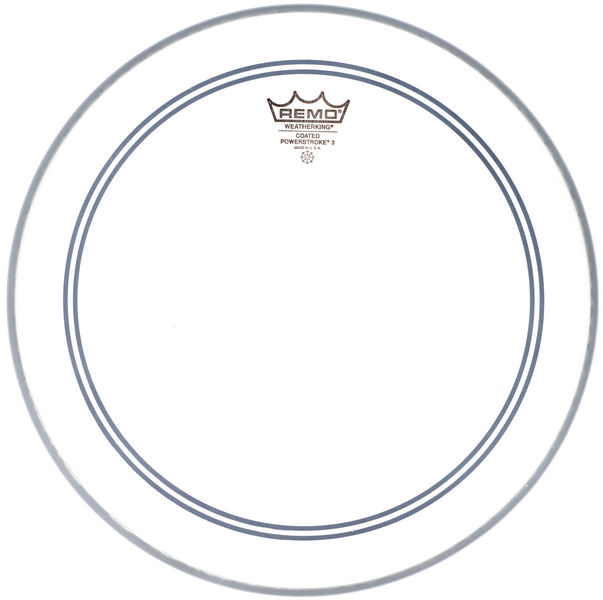 Remo Powerstroke P3 Clear is another Remo single ply, 10mil drum head. The difference between this and Ambassador Clear is the 3mil inlay ring.
Remo Powerstroke P3 Clear is another Remo single ply, 10mil drum head. The difference between this and Ambassador Clear is the 3mil inlay ring.
It delivers a well-defined bright attack while the inlay ring reduces the sustain and excessive overtones.
Combining a single-ply with the inlay ring provides a great balance between sensitivity and control.
The sizes available range from 6” to 36” and they work well as a snare, tom, and bass drum heads, with the latter having a 10min inlay ring instead.
As single-ply clear drum heads, they are not the most durable. Avoid them if durability is what you value the most.
If you’re looking for a responsive drum head that removes excessive overtones, the Remo Powerstroke P3 Clear is a great option.
On the other hand, if you plan to play with brushes or prefer a warmer drum sound, the Remo Powerstroke P3 Coated is a better alternative.
The coating of the Powerstroke P3 Coated removes some of the attack and brightness while maintaining the responsiveness found in the P3 Clear.
Best Bass Drum Heads
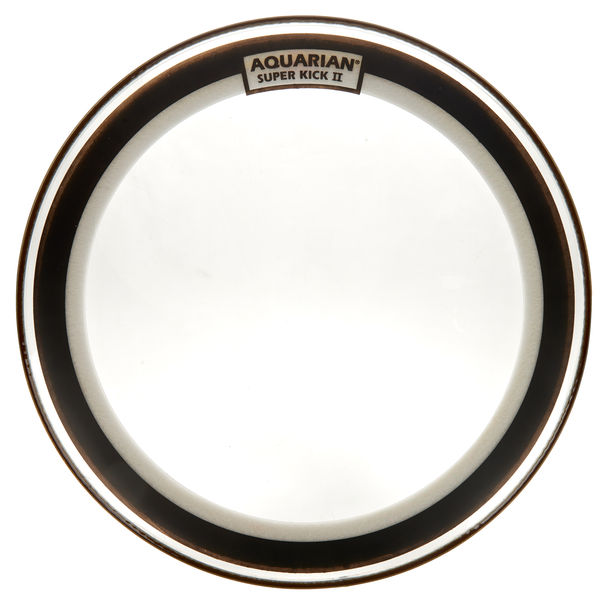 Let’s be honest, the bass drum gets hit the hardest, which makes it extremely important to buy a durable bass drum head.
Let’s be honest, the bass drum gets hit the hardest, which makes it extremely important to buy a durable bass drum head.
With that in mind, the first bass drum head that deserves a spot on my list, is the Aquarian Super-Kick II Clear.
It’s made of two plies of 7mil clear film combined with Aquarian’s patented “Floating Muffling System”
The floating muffling system is perfect, as it’s only partially attached to the drum heads, so it moves freely every time you hit.
That reduces annoying overtones and enhances the low-end frequencies of the kick, without choking the drum head too much and maintaining a natural sound.
It results in a well-defined punchy sound and avoids the usage of external muffling or everyday items like pillows and blankets.
The Superkicks II are available in sizes ranging from 14” to 28”. If you value brightness and sustain over durability, you can buy the Superkick I instead.
Available in both Clear and Coated finish, it’s made of a single 10mil ply, something I tend to avoid for the bass drum.
On the other hand, if you value durability over responsiveness and brightness, the Superkick 10, available in both Clear and Coated finishes, is, on par with Evans EMAD Heavyweight, one of the most durable drum heads anyone can buy.
For me though, the Aquarian Superkick II is the perfect balance between sound and durability anyone should aim for.
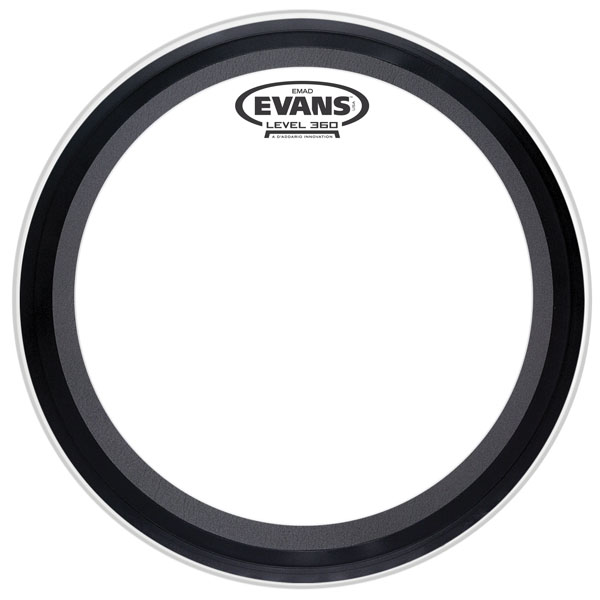 The Evans EMAD2 Clear is similar to the Aquarian Superkick II. It features two plies, with one being 10mil and the other 7mil.
The Evans EMAD2 Clear is similar to the Aquarian Superkick II. It features two plies, with one being 10mil and the other 7mil.
EMAD comes from the Externally Mounted Adjustable Damping where you attach the two foam dampening rings the head comes with.
One of the rings is wider than the other, so you can adjust how much sustain and overtones you want, by playing without any, or with one of the rings.
The fact that it’s externally mounted makes it easy to control the dampening without the need to remove the bass drum head, making this the most versatile bass drum head on the market.
If the EMAD2 is not responsive enough for you, you can choose the Evans EMAD, available in both clear and coated finishes, and a single 10mil ply instead.
The clear version is brighter, with more overtones and increased responsiveness.
Perhaps you feel like the EMAD2 is too responsive or you don’t value the sound as much as durability. In that case, the EMAD Heavyweight Clear is what you’re looking for, with two 10mil plies and the same EMAD system.
In other words, pick between the EMAD Clear, EMAD Coated, EMAD2, EMAD Heavyweight depending on how much responsiveness and sustain you’re looking for, and how bright or warm you want your sound to be.
From left to right, the sound gets warmer and the drum head less responsive while the sustain and overtones decrease.
 This is probably the least exciting bass drum head on the list, but don’t let that fool you, it’s a good one.
This is probably the least exciting bass drum head on the list, but don’t let that fool you, it’s a good one.
After suggesting the Powerstroke P3 for the snare drum, I couldn’t help but suggest it for the bass drum too, since I consider it one of the best options, after the Superkick II and EMAD2.
The bass drum head is constructed with a single 10mil film and a 10mil inlay ring, as is by far the most responsive one of the three suggested bass drum heads.
It also provides more brightness and attack, when compared to the previous two, and it’s also more sensitive thanks to the single ply.
The 10mil inlay ring doesn’t muffle as much as the ones on the Superkick II and EMAD2 but provides a good balance between sensitivity and control.
The Powerstroke P3 is available in sizes ranging from 6” to 28”, and if the P3 Clear is too bright or provides too much sustain and overtones, buy the Powerstroke P3 Coated instead.
The coated version has less attack and sustain, with easily controllable overtones and warm sound.
Both versions are not that durable, especially when used as bass drum heads, mostly because of being single ply.
Best Tom Drum Heads
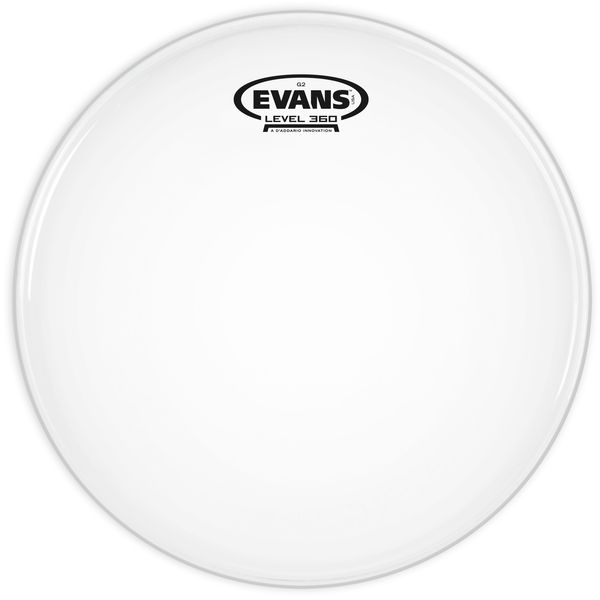 As far as toms go, the best option is to buy a drum head pack with three or four drum heads that accommodate most drum sets configurations.
As far as toms go, the best option is to buy a drum head pack with three or four drum heads that accommodate most drum sets configurations.
Evans G2 is one of the most popular drum heads on the market and you’ll understand why.
They are 2-ply drum heads with both plies being 7mil film. That makes them thicker and therefore, more durable than single-ply drum heads.
The clear version offers a bright attack and a decent amount of sustain, keeping enough overtones without ever becoming an annoyance.
If for some reason you still think it allows for too much sustain and overtones, you can buy the Coated version instead, which is slightly warmer and has a reduced amount of sustain and overtones.
Being 2-ply makes them not as responsive as single-ply drum heads, but I find them responsive enough for most musical applications and you avoid the shorter lifespan of single-ply drum heads.
They don’t have any additional dampening, so the two plies and the coating (if applicable) are everything you have to work with. You can add external muffling if needed, but it’s usually not the case.
All in all, they are perfectly balanced drum heads, that control unwanted sustain and annoying overtones while allowing your drums to resonate.
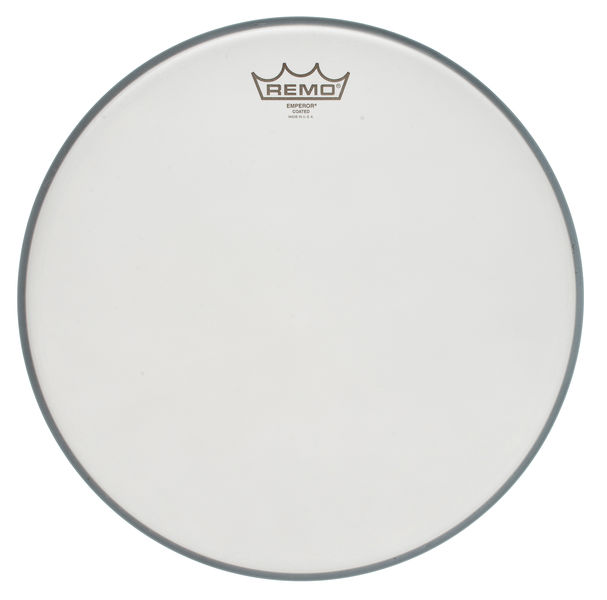 Remo manufactures the Emperors with two plies of 7mil film and no additional dampening, like dots or rings.
Remo manufactures the Emperors with two plies of 7mil film and no additional dampening, like dots or rings.
They provide good sustain and decent durability. In terms of sound, I consider them bright with a powerful attack, making them great for loud live performances.
Double plies do a good at keeping excessive overtones under control, but external dampening may be needed, depending on the sound you’re looking for.
Being clear makes them versatile enough for most musical applications, but less durable and harder to avoid the annoying sustain and overtones.
If that’s too much for you to handle, you can always opt for the Emperor Coated drum heads that bring a little bit of durability, less attack, and a warmer sound.
The coating adds the much-needed extra definition for ghost notes and brushes that the clear version doesn’t have.
If you’re an Evans type of guy, the Emperor drum heads are the closest thing you can get to the Evans G2.
Overall, they’re balanced drum heads that are right in the middle when it comes to attack, durability, sustain, and responsiveness.
That makes them great options for anyone looking to buy new drum heads as they serve many purposes that other specific drum heads don’t.
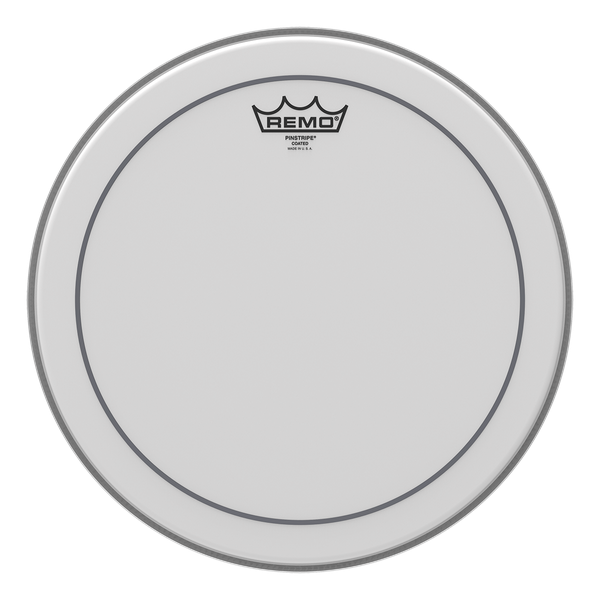 Besides the Evans G2 and the Remo Emperors, another obvious choice is the Remo Pinstripe drum heads.
Besides the Evans G2 and the Remo Emperors, another obvious choice is the Remo Pinstripe drum heads.
To no one’s surprise, Remo builts the Pinstripes with a couple of 7mil ply, just like the other two alternatives.
Those two plies are perfect to control unwanted overtones, and they even include an overtone reducing agent between the two to improve that same control.
As far as the sounds go, the clear version offers a bright sound with short sustain and controlled overtones.
On the other hand, if you want the same level of sustain and overtones, but with a warmer sound instead, go with the coated option. That should also be your go-to if you plan on playing with brushes.
Being 2-ply drumheads guarantees enough durability for most situations, so they should last you a decent amount of time.
On top of that, the Pinstripes are available in sizes ranging from 6” to 30”. That means you can use them as your bass drumhead despite not being the best for the job.
In the end, their versatility makes them one of the most popular drum heads in the world.
If you like to have the sustain and overtones under control, and a medium to high volume, the Pinstripes are some of the best on the market.
Final Words
Unlike most of my articles, this one doesn’t focus on the definitive best. Best is subjective, but that’s especially true when it comes to drumheads.
Instead, my goal was to provide you a list of the best all-around drum heads for the toms, snare, bass drum.
What I mean by that is that every single drumhead mentioned in this article is considered an industry standard.
They offer above-average durability, a versatile sound that works with most musical genres, and are easy to tune and get a good sound out of it.
Anyway, I’m sure you won’t be disappointed with whatever combination you decide to go with, from all the drumheads mentioned above.
In the end, I hope this article achieved its main purpose of educating you on the different types of drumheads, what to look for when shopping and which are the all-around best drum heads.

